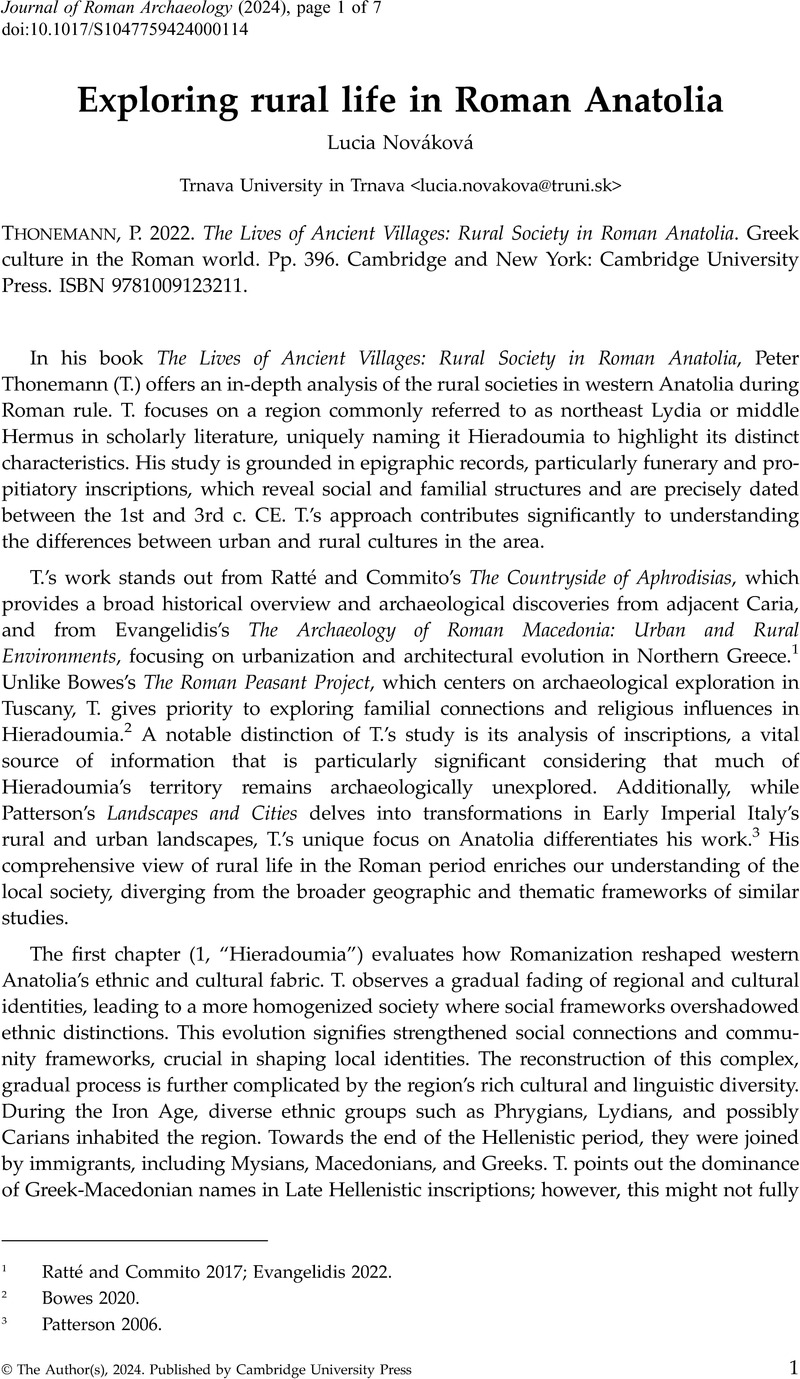No CrossRef data available.
Article contents
Exploring rural life in Roman Anatolia - P. Thonemann 2022. The Lives of Ancient Villages: Rural Society in Roman Anatolia. Greek culture in the Roman world. Pp. 396. Cambridge and New York: Cambridge University Press. ISBN 9781009123211.
Review products
P. Thonemann 2022. The Lives of Ancient Villages: Rural Society in Roman Anatolia. Greek culture in the Roman world. Pp. 396. Cambridge and New York: Cambridge University Press. ISBN 9781009123211.
Published online by Cambridge University Press: 30 April 2024
Abstract
An abstract is not available for this content so a preview has been provided. Please use the Get access link above for information on how to access this content.

- Type
- Book Review
- Information
- Copyright
- Copyright © The Author(s), 2024. Published by Cambridge University Press
References
Borchhardt, J. 2016. “Likya Beyleri ve Tapınak Mezarları.” In Lukka'dan Likya'ya: Sarpedon ve Aziz Nikolaos'un Ülkesi, ed. İşkan, H. and Dündar, E., 402–9. Istanbul: Yapı Kredi Yayınları.Google Scholar
Bowes, K. 2020. The Roman Peasant Project 2009–2014: Excavating the Roman Rural Poor. University Museum Monograph 154. Philadelphia: University of Pennsylvania Museum of Archaeology and Anthropology.Google Scholar
Bruns-Özgan, C. 1987. Lykische Grabreliefs des 5. und 4. Jahrhunderts v. Chr. IstMitt-BH 33. Tübingen: Wasmuth.Google Scholar
Bruns-Özgan, C. 2016. “Klasik Dönem Likya Yontuculuğu: Biçem ve Yorum.” In Lukka'dan Likya'ya: Sarpedon ve Aziz Nikolaos'un Ülkesi, ed. İşkan, H. and Dündar, E., 474–91. Istanbul: Yapı Kredi Yayınları.Google Scholar
Bryce, T. R. 1979. “Lycian tomb families and their social implications.” JESHO 22: 296–313.Google Scholar
Bryce, T. R. 1991. “Tombs and the social hierarchy in ancient Lycia.” Altorientalische Forschungen 18, no. 1: 73–85.CrossRefGoogle Scholar
Çevik, N. 2015. Lykia Kitabı. Suna-İnan Kıraç Akdeniz Medeniyetleri Araştırma Enstitüsü Monografi Dizisi 10. Antalya: AKMED Yayınları.Google Scholar
Evangelidis, V. 2022. The Archaeology of Roman Macedonia: Urban and Rural Environments. Oxford: Oxbow Books.CrossRefGoogle Scholar
Işık, C. 2020. “The mural paintings of the Hekatomneion: Observations on figural types, composition, iconography and style.” In Uzunyuva Hekatomneion in Mylasa, ed. Diler, A., 289–321. Istanbul: Ege Yayinlari.Google Scholar
Işık, F. 2020. “The Sarcophagus of Hekatomnos.” In Uzunyuva Hekatomneion in Mylasa, ed. Diler, A., 199–287. Istanbul: Ege Yayinlari.Google Scholar
Işın, G., and Yıldız, E.. 2017. “Tomb ownership in Lycia: Site selection and burial rights with selected rock tombs and epigraphic material from Tlos.” In Life and Death in Asia Minor in Hellenistic, Roman and Byzantine Times, ed. Brandt, J. R., Hagelberg, E., Bjornstad, G., and Ahrens, S., 85–108. Studies in Funerary Archaeology 10. Oxford: Oxbow Books.Google Scholar
LaBuff, J. 2013. “Who(’)s(e) Karian? Languages, names, and identity.” The Ancient History Bulletin 27, no. 3–4: 86–107.Google Scholar
Marchese, R. T. 1989. The Historical Archaeology of Northern Caria: A Study in Cultural Adaptation. BAR 536. Oxford: British Archaeological Reports.Google Scholar
McLean, B. H. 2002. An Introduction to Greek Epigraphy of the Hellenistic and Roman Periods from Alexander the Great down to the Reign of Constantine (323 BC–AD 337). Ann Arbor: University of Michigan Press.Google Scholar
Patterson, J. R. 2006. Landscapes and Cities: Rural Settlement and Civic Transformation in Early Imperial Italy. Oxford: Oxford University Press.CrossRefGoogle Scholar
Payne, A. 2007. “Multilingual inscriptions – signs of power or weakness?” In Margins of Writing, Origins of Cultures, ed. Sanders, S. L., 119–34. Chicago: University of Chicago Press.Google Scholar
Ratté, C., and Commito, A.. 2017. The Countryside of Aphrodisias. Kelsey Museum Publication 15. Ann Arbor: Kelsey Museum of Archaeology.Google Scholar
Rosen, K. 1987. “Ehrendekrete, Biographie und Geschichtsschreibung: Zum Wandel der griechischen Polis im frühen Hellenismus.” Chiron 17: 277–92.Google Scholar
Rutherford, I. 2002. “Lycian-Greek bilingualism filiation formulas and other forms of interference.” In Bilingualism in Ancient Society: Language Contact and the Written Word, ed. Adams, J., Janse, M., and Swain, S., 197–219. Oxford: Oxford University Press.CrossRefGoogle Scholar
Schuler, C. 2012. “Inscriptions and identities of rural population groups in Roman Asia Minor.” In Epigraphy and the Historical Sciences, ed. Davies, J. and Wilkes, J., 63–100. Proceedings of the British Academy 177. Oxford: Oxford University Press.Google Scholar
Tofi, M. G. 2006. “The banquet iconography in the funerary reliefs of Archaic and Classical Lycia.” In III. Uluslararası Likya Sempozyumu, 07–10 Kasım, 2005, ed. Dörtlük, K., Varkıvanç, B., Kahya, T., des Courtils, J., Doğan-Alpaslan, M., and Boyraz, R., 829–46. Antalya: AKMED Yayınları.Google Scholar




